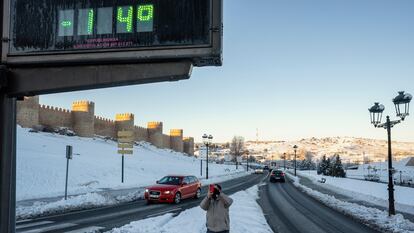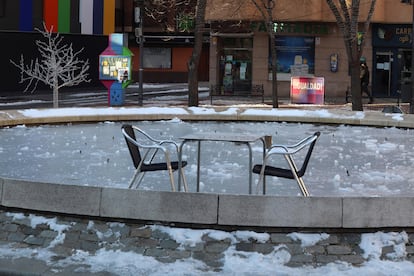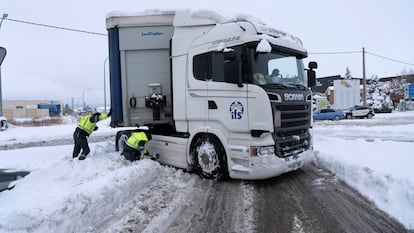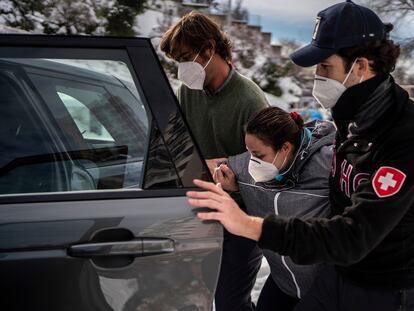After being blasted by blizzard, Spain reels from record low temperatures
Thermometers fall to as low as -25ºC in Guadalajara and hospitals fill up with admissions for falls as deep snow from Storm Filomena turns into ice

On Tuesday, half of Spain was still struggling to deal with the cold snap that has followed on the heels of Storm Filomena, a blizzard that blanketed many parts of the country with record snowfall this weekend, leaving several dead and thousands stranded on roads.
A severe drop in temperatures has now turned accumulated snow into ice, multiplying the risk of falls, creating dangerous driving conditions and testing authorities’ ability to respond to the numerous calls for help. In Madrid, citizens with four-wheel-drive vehicles were volunteering to take people to hospitals as ambulances struggled to cope with demand and the weather conditions.
In a country dealing with a fresh surge of the coronavirus pandemic, maintaining critical infrastructure operational and guaranteeing the supply of essential goods has suddenly become the new, most urgent challenge for officials at all levels of government.

“Our efforts are focused on ensuring the supply of basic goods such as food and medicine, clearing access to logistics centers and bringing back freight traffic,” said Transportation Minister José Luis Ábalos.
Schoolchildren in Madrid, which experienced the biggest snowstorm in living memory this past weekend, have been told to stay home until January 18 while roads are cleared and school buildings checked for damage. The unusual weather has also affected the courts, where trials were suspended on Monday and Tuesday. It was expected that Mercamadrid, one of the world’s largest wholesale markets, would reopen on Tuesday in more or less normal conditions.
Authorities in Castilla-La Mancha on Tuesday were considering whether to apply for a disaster area declaration. Officials were consulting with business, union and local leaders in a bid to assess the damage caused by the severe weather event. The central region, which includes the city of Toledo, has experienced some of the coldest temperatures and biggest snow accumulations in the country.
During what’s left of the week, we will go from suffering temperatures a lot colder than normal, to suffering temperatures somewhat colder than normalRubén del Campo, Aemet spokesman
In Madrid, another region hard hit by the blizzard, the capital’s leaders said two days ago that they would seek disaster declaration for the city. Interior Minister Fernando Grande-Marlaska initially ruled it out, but on Monday he said it might be possible while underscoring the need for adequate damage assessment.
Madrid regional premier Isabel Díaz Ayuso, of the Popular Party (PP), on Tuesday insisted on the need for such a move. “The declaration of a disaster zone is essential to repair damage in many highly affected locations. We will support any mayor from any town and any political ideology who requests it,” she said.
For now, no local or regional authority has formally applied for aid. The central government, led by a center-left coalition of the Socialist Party (PSOE) and Unidas Podemos, on Tuesday held a Cabinet meeting that addressed the ongoing effects of the storm but concluded that it is still too early to put a number on the damage to public and private infrastructure.
“We have started to evaluate the damage,” said Grande-Marlaska about the possibility of declaring disaster zones in parts of Spain. “When the [weather] alert ends and we have an assessment, a decision will be made.”

There were record lows in parts of central and eastern Spain, and four regions – Castilla-La Mancha, Castilla y León, Madrid and Aragón – were on red alert for cold weather on Tuesday. A total of 41 out of the country’s 50 provinces were under an advisory for low morning temperatures, including some of Spain’s normally warmest spots such as Valencia, Barcelona, Seville and Murcia.
The night of Monday to Tuesday was “the coldest in the entire county at least since the cold snap of 2001,” said Rubén del Campo, spokesman for the national weather agency AEMET. At 8.30am, readings on thermometers showed -25.2ºC in Molina de Aragón (Guadalajara), -21.3 ºC in Calamocha (Teruel), and -21 ºC in the city of Teruel.
The transportation system has been particularly hard hit. There were traffic cuts on 116 roads on Tuesday morning, snow chains were mandatory on 210 roads, and the Adolfo-Suárez Barajas Airport in the Spanish capital had yet to go back to normal activity, although flights have resumed at Terminal 4 – home to Iberia and British Airways, among other airlines.
“This is not over,” warned Grande-Marlaska on Monday, as he asked citizens to avoid road travel as much as possible. “It is essential to maintain all safety precautions and not let ourselves be fooled by the clear skies. Snow can become a trap for vehicles and citizens.”
Meteorologists, however, believe that the worst of it has passed. Although snow will remain on the ground for many days to come, the cold air front is expected to start retreating from the peninsula. “During what’s left of the week, we will go from suffering temperatures a lot colder than normal, to suffering temperatures somewhat colder than normal,” said Aemet spokesman Del Campo.
Defense Minister Margarita Robles noted that the emergency room of Madrid’s Gómez Ulla hospital, a military facility, has seen a sudden rise in the number of admissions for falls. And at Gregorio Marañón hospital, 85 out of 130 emergencies on Monday morning were for falls, the news agency Efe reported.
The effort to clear roads and rescue people has required help from the military. The army deployed 1,100 troops, of whom 600 were part of the Emergency Military Unit, mostly in Madrid but also in Aragón and Toledo.
Late on Monday, there were no more trapped trucks, compared with the 7,100 that required assistance on Sunday night. And shipments of the coronavirus vaccine were delivered despite the difficult conditions.
A total of 1,300 snow plows were deployed throughout the territory, and they were still on the roads this week in parts of Aragón, Cantabria, Castilla-La Mancha, Castilla y León, Catalonia, Valencia, Extremadura, La Rioja and Madrid. By Monday they had spread 246,000 tons of de-icing agents on 30,000 kilometers of roads.
The dramatic drop in temperature caused power cuts in Madrid and Toledo, and also affected the electricity supply to railway lines in León and Asturias. But all the medium and long-distance high-speed lines were newly operational by Tuesday.
English version by Susana Urra.
Tu suscripción se está usando en otro dispositivo
¿Quieres añadir otro usuario a tu suscripción?
Si continúas leyendo en este dispositivo, no se podrá leer en el otro.
FlechaTu suscripción se está usando en otro dispositivo y solo puedes acceder a EL PAÍS desde un dispositivo a la vez.
Si quieres compartir tu cuenta, cambia tu suscripción a la modalidad Premium, así podrás añadir otro usuario. Cada uno accederá con su propia cuenta de email, lo que os permitirá personalizar vuestra experiencia en EL PAÍS.
¿Tienes una suscripción de empresa? Accede aquí para contratar más cuentas.
En el caso de no saber quién está usando tu cuenta, te recomendamos cambiar tu contraseña aquí.
Si decides continuar compartiendo tu cuenta, este mensaje se mostrará en tu dispositivo y en el de la otra persona que está usando tu cuenta de forma indefinida, afectando a tu experiencia de lectura. Puedes consultar aquí los términos y condiciones de la suscripción digital.
More information
Últimas noticias
ChatGPT fails the test: This is how it endangers the lives of minors
The late consecration of women artists in their 90s
The Florida Keys tourist paradise is besieged by immigration agents: ‘We’ve never seen anything like this’
The latest scam on WhatsApp behind the legal dream: using immigration status as bait
Most viewed
- Families demand repatriation of bodies of Colombians who died in Ukraine: ‘This war is a slaughterhouse for foreigners’
- The low-cost creative revolution: How technology is making art accessible to everyone
- Liset Menéndez de la Prida, neuroscientist: ‘It’s not normal to constantly seek pleasure; it’s important to be bored, to be calm’
- Christian Louboutin: ‘Young people don’t want to be like their parents. And if their parents wear sneakers, they’re going to look for something else’
- ‘El Limones’ and the growing union disguise of Mexican organized crime










































